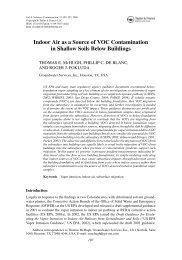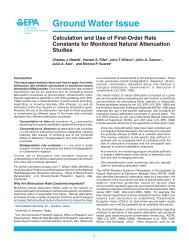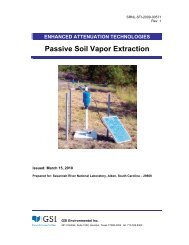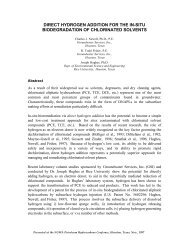Parameter Estimation Guidelines for Risk-Based Corrective Action ...
Parameter Estimation Guidelines for Risk-Based Corrective Action ...
Parameter Estimation Guidelines for Risk-Based Corrective Action ...
You also want an ePaper? Increase the reach of your titles
YUMPU automatically turns print PDFs into web optimized ePapers that Google loves.
Groundwater Services, Inc.<br />
Continued<br />
Definitions <strong>for</strong> Cross-Media Transfer Equations<br />
D s<br />
eff<br />
eff<br />
D ws<br />
Effective diffusivity in vadose zone soils:<br />
eff ⎡ cm 2 ⎤<br />
D s ⎢ ⎥<br />
⎣⎢<br />
s<br />
⎦⎥ = θ Dair as<br />
3.33 ⎡<br />
+ Dwat ⎤<br />
2 ⎢ ⎥<br />
θ T ⎣⎢<br />
H<br />
⎦⎥<br />
⎡ 3.33<br />
θ ws<br />
⎤<br />
⎢ 2 ⎥<br />
⎣⎢<br />
θ T ⎦⎥<br />
Effective diffusivity above the water table:<br />
D<br />
eff<br />
ws<br />
⎡<br />
⎢<br />
cm ⎣ s<br />
2<br />
⎤<br />
⎥ = hcap<br />
+ h<br />
⎦<br />
⎡ h<br />
⎢<br />
⎣⎢<br />
D<br />
(<br />
cap<br />
v ) eff<br />
+<br />
cap<br />
h<br />
D<br />
v<br />
eff<br />
s<br />
d Lower depth of surficial soil zone (cm)<br />
d s Thickness of affected subsurface soils<br />
D air Diffusion coefficient in air (cm 2 /s)<br />
D wat Diffusion coefficient in water (cm 2 /s)<br />
ER Enclosed-space air exchange rate (l/s)<br />
f oc Fraction of organic carbon in soil (g-C/g-soil)<br />
H Henry’s law constant (cm 3 -H 2 O)/(cm 3 -air)<br />
h cap Thickness of capillary fringe (cm)<br />
h v Thickness of vadose zone (cm)<br />
I Infiltration rate of water through soil (cm/year)<br />
k oc Carbon-water sorption coefficient (g-H 2 O/g-C)<br />
k s Soil-water sorption coefficient (g-H 2 O/g-soil)<br />
L B Enclosed space volume/infiltration area ratio (cm)<br />
L crack Enclosed space foundation or wall thickness (cm)<br />
L GW Depth to groundwater = h cap + h v (cm)<br />
L s Depth to subsurface soil sources (cm)<br />
P e Particulate emission rate (g/cm 2 -s)<br />
U air Wind speed above ground surface in ambient mixing<br />
zone (cm/s)<br />
V gw Groundwater Darcy velocity (cm/s)<br />
⎤<br />
⎥<br />
⎦⎥<br />
−1<br />
eff<br />
D crack<br />
eff<br />
D cap<br />
W<br />
δ air<br />
δ gw<br />
η<br />
Effective diffusivity through foundation cracks:<br />
eff ⎡ cm 2 ⎤<br />
D crack ⎢ ⎥<br />
⎣⎢<br />
s<br />
⎦⎥ = θ 3.33 ⎡<br />
Dair acrack<br />
+ Dwat ⎤ ⎡<br />
2 ⎢ ⎥ ⎢<br />
θ T ⎣⎢<br />
H<br />
⎦⎥<br />
⎣⎢<br />
Effective diffusivity in the capillary zone:<br />
eff ⎡ cm 2 ⎤<br />
D cap ⎢ ⎥<br />
⎣⎢<br />
s<br />
⎦⎥ = θ 3.33<br />
Dair acap ⎡<br />
+ Dwat ⎤<br />
2 ⎢ ⎥<br />
θ T ⎣⎢<br />
H<br />
⎦⎥<br />
3.33<br />
θ wcrack<br />
2<br />
θ T<br />
⎡ 3.33<br />
θ wcap<br />
⎤<br />
⎢ ⎥<br />
2<br />
⎢<br />
⎣<br />
θ T ⎥<br />
⎦<br />
Width of source area parallel to wind, or groundwater flow<br />
direction (cm)<br />
Ambient air mixing zone height (cm)<br />
Groundwater mixing zone thickness (cm)<br />
Areal fraction of cracks in foundations/walls<br />
(cm 2 -cracks/cm 2 -total area)<br />
θacap Volumetric air content in capillary fringe soils<br />
(cm 3 -air/cm 3 -soil)<br />
θ acrack Volumetric air content in foundation/wall cracks<br />
(cm 3 -air/cm 3 total volume)<br />
θ as<br />
Volumetric air content in vadose zone soils<br />
(cm 3 -air/cm 3 -soil)<br />
θ T Total soil porosity (cm 3 -pore-space/ cm 3 -soil)<br />
θwcap Volumetric water content in capillary fringe soils<br />
(cm 3 -H 2 O/cm 3 -soil)<br />
θ wcrack Volumetric water content in foundation/wall cracks<br />
(cm 3- H 2 O)/cm 3 total volume)<br />
θ ws Volumetric water content in vadose zone soils<br />
(cm 3 -H 2 O/cm 3 -soil)<br />
ρ s Soil bulk density (g-soil/cm 3 -soil)<br />
τ Averaging time <strong>for</strong> vapor flux (s)<br />
⎤<br />
⎥<br />
⎦⎥<br />
FIGURE 2. CROSS-MEDIA PARTITIONING EQUATIONS IN THE RBCA SPREADSHEET SYSTEM<br />
LATERAL TRANSPORT FACTORS<br />
During lateral transport within air or groundwater, COC concentrations in the flow stream will be<br />
diminished due to mixing and attenuation effects (see Figure 1). Site-specific attenuation factors<br />
characterizing COC mass dilution or loss during lateral transport can be estimated using the air<br />
dispersion and groundwater transport models provided in the RBCA Spreadsheet System. Equations <strong>for</strong><br />
the steady-state analytical transport models incorporated in the RBCA spreadsheet are shown on<br />
Figure 3. Equations LT-1 and LT-2 correspond to the Domenico 3-D groundwater solute transport model<br />
and the standard gaussian air dispersion model, respectively. The user must provide in<strong>for</strong>mation<br />
regarding COC properties and transport parameters (flow velocities, dispersion coefficients,<br />
retardation factors, decay factors, etc.), as required <strong>for</strong> the selected contaminant transport model.<br />
Procedures <strong>for</strong> definition of the contaminant source term <strong>for</strong> the groundwater solute model (Equation LT-<br />
1) are illustrated on Figure 4. Key assumptions of these lateral transport models are detailed in the<br />
Tier 2 RBCA Guidance Manual (Connor et al, 1995).<br />
NGWA Petroleum Hydrocarbons Conference 6 <strong>Parameter</strong> <strong>Estimation</strong> <strong>Guidelines</strong><br />
Houston, Texas, November 1996<br />
<strong>for</strong> RBCA Modeling






